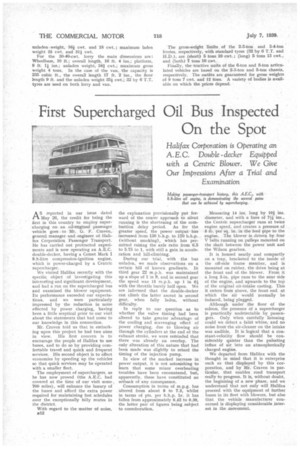First Supercharged Oil Bus Inspected On the Spot
Page 46

If you've noticed an error in this article please click here to report it so we can fix it.
AS reported in our issue dated May 26, the credit for being the first in this country to employ supercharging on an oil-engined passenger vehicle goes to Mr. G. F. Craven, general manager and engineer of Halifax Corporation Passenger Transport. He has carried out protracted experiments and is now operating an A.E.C. double-decker, having a Comet Mark I 8.8-litre compression-ignition engine, which is power-charged by a Centric supercharger.
We visited Halifax recently with the specific object of investigating this interesting and significant development, and had a run on the supercharged bus and examined the blower equipment. Its performance exceeded our expectations, and we were particularly impressed by the reduction in noise effected by power charging, having been a little sceptical prior to our visit about the statements that had come to our knowledge in this connection.
Mr. Craven told us that in embarking upon this project he had two aims in view. His first concern is to encourage the people of Halifax to use buses, and to do so by providing comfortable travel and quick and frequent services. His second object is to effect economies by speeding up the vehicles so that quick services may be operated with a smaller fleet.
The employment of superchargers, as he has now proved (the A.E.C. had covered at the time of our visit some 700 miles), will enhance the luxury of the buses and afford the extra power required for maintaining fast schedules over the exceptionally hilly mutes in the district.
With regard to the matter of noise, 512
the explanation provisionally put forward of the nearer approach to silent running is the shortening of the combustion delay period. As for the greater speed, the power output• has increased from 130 b.h.p. to 170 b.h.p. (without smoking), which has permitted raising the axle ratio from 6.5 to 5.75 to 1, with still a gain in acceleration and hill-climbing.
During our trial, with the bus unladen, we made observations on a certain hill of known gradients. In third gear 22 m.p.h. was maintained up a slope of 1 in 9, and in second gear the speed was 15 m.p.h. up 1 in 6i with the throttle barely half open. We are informed that the double-decker can climb the latter ascent in second gear, when fully laden, without difficulty.
In reply to our question as to whether the valve timing had been altered to take greater advantage of the cooling and scavenging effect of power charging, due to blowing air through the cylinders at the end of the exhaust stroke, we were reminded that there was already an overlap. The only alteration of this nature that had been made was slightly to retard the timing of the injection pump.
In view of the marked increase in power output, it is not astonishing to learn that some minor overheating troubles have been encountered, but, apparently, these have constituted no setback of any consequence.
Consumption in terms of m.p.g. has altered from about 8 to 7.3, whilst in terms of pts. per b.h.p. hr. it has fallen from approximately 0.42 to 0.39, the latter pair of figures being subject to corroboration. Measuring 14 ins, long by IOt diameter, and with a bore of 74 ins., the Centric supercharger runs at twice engine speed, and creates a pressure of 5 lb. per sq. in. in the feed pipe to the engine. The blower is driven by four V belts running on pulleys mounted on the shaft between the power unit and the Wilson gearbox.
It is housed neatly and compactly on a tray, bracketed to the inside of the off-side frame member, and is mounted on rubber, the drive being at the front end of the blower. From it a long 2-in, pipe runs to the near side of the engine, and upwards to the top of the original air-intake casting. This it enters from above, the front end. at Which the air would normally be induced, being plugged.
Although under the floor of the saloon, the presence of a supercharger is practically undetectable by passengers. Only when carefully listening could we detect a faint whine, and no noise from the air-cleaner on the intake was audible. It is logical that a constant-velocity flow should be considerably quieter than the pulsating influx of air into an atmospherically charged engine.
We departed from Halifax with the thought in mind that it is enterprise such as that displayed by this corporation, and by Mr. Craven in particular, that enables road transport really to progress. It is, without doubt, the beginning of a new phase, and we understand that not only will Halifax proceed with the equipment of further buses in its fleet with blowers, but also that the vehicle manufacturer concerned is displaying considerable interest in the movement.




















































































